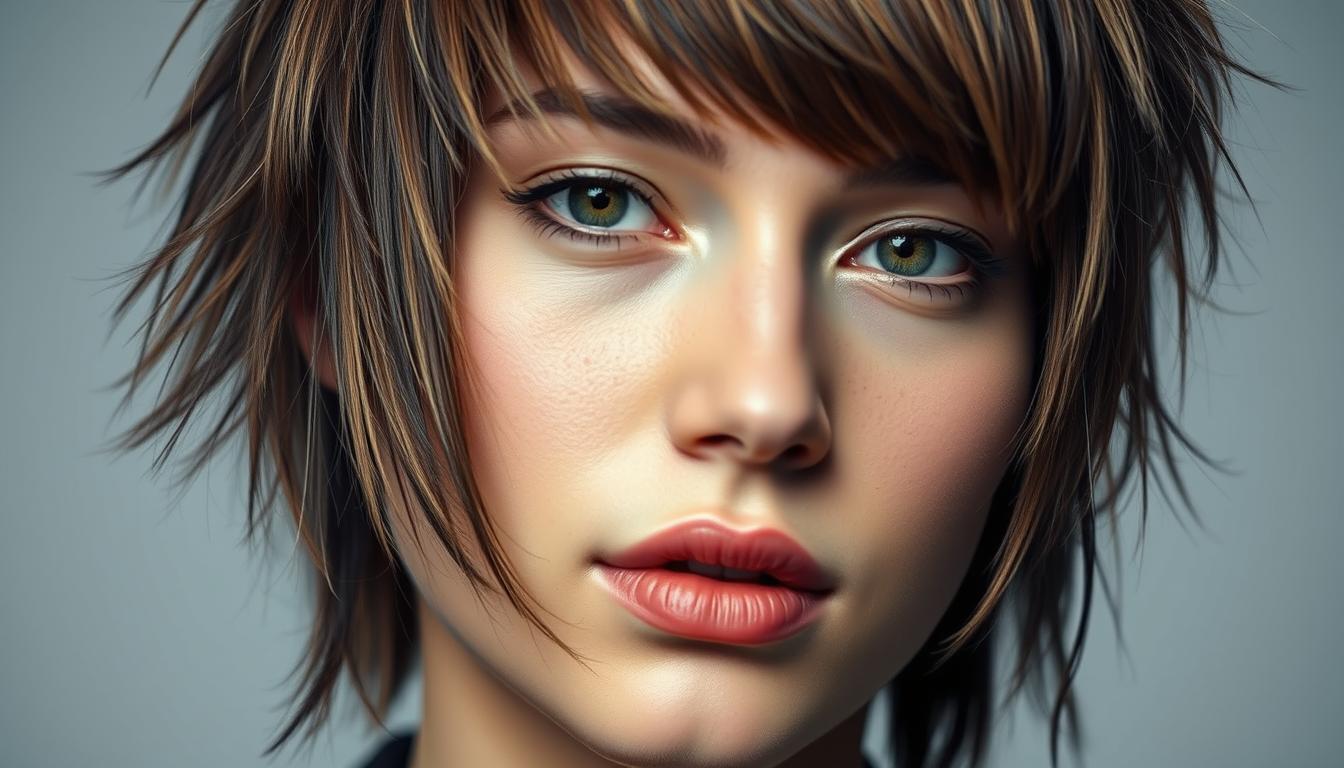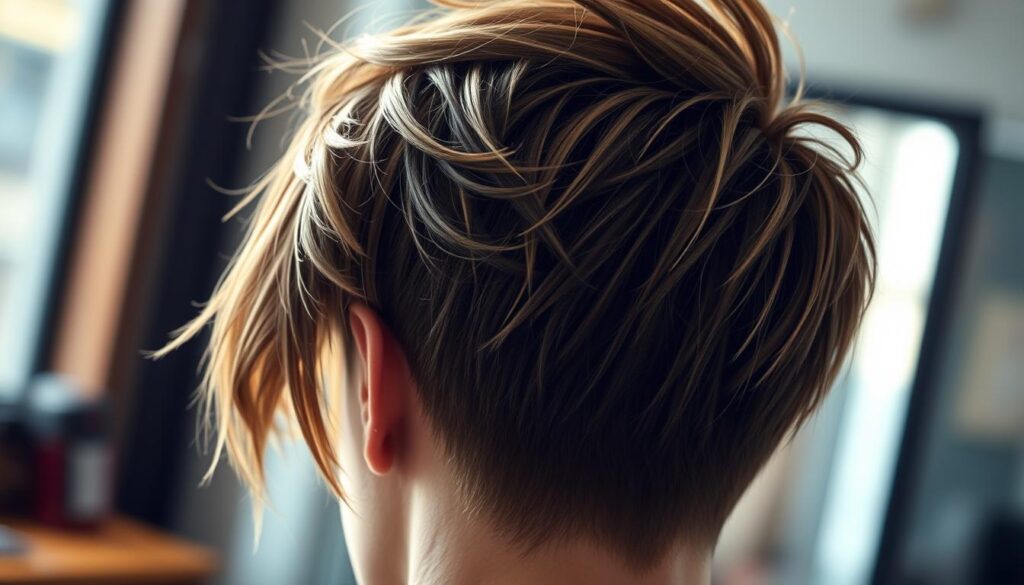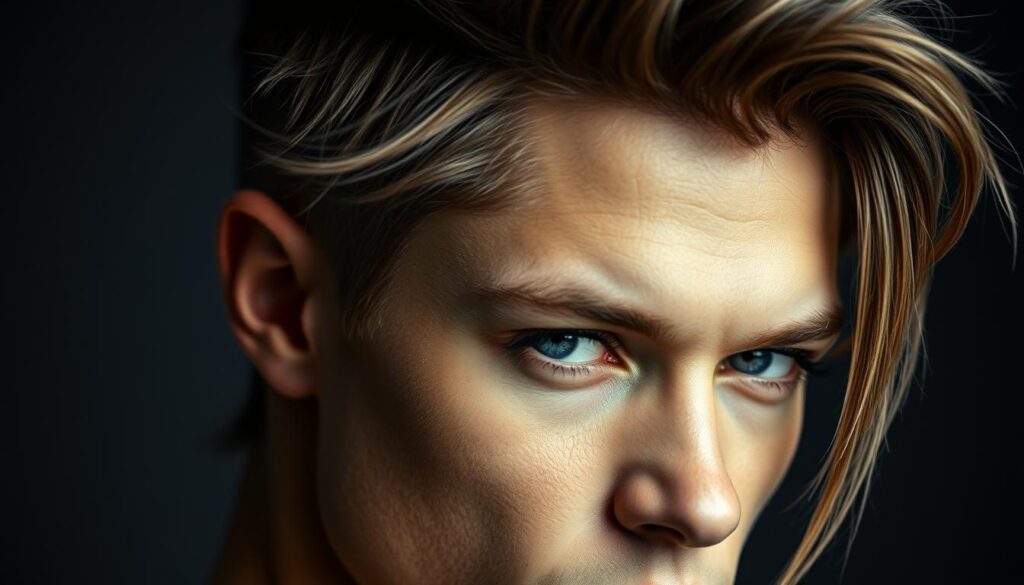
What if your hair could be both wild and polished at the same time? The answer lies in a trend that’s rewriting the rules of modern hairstyling. Meet the wolf cut – a bold mix of vintage vibes and contemporary edge that’s perfect for anyone craving effortless cool.
This hairstyle blends the shag’s layered energy with the mullet’s playful shape, but ditches outdated bulkiness. Think voluminous texture up top, softer waves at the ends, and a shape that looks like you just stepped out of a windstorm (in the best way). It’s no wonder TikTok and Instagram feeds exploded with this look in 2022 – and it’s still going strong.
What makes the wolf cut stand out? It’s low-fuss but high-impact. Whether your hair is pin-straight or curly, thick or fine, this style adapts. You get movement without constant styling, and that “I woke up like this” charm that works for office days or weekend adventures.
Key Takeaways
- Modern twist on 80s-inspired layers
- Works for all hair types and lengths
- Requires minimal daily styling
- Popularized through social media trends
- Customizable for subtle or bold looks
Introduction to the Wolfcut Phenomenon
When Seoul’s streets became runways for edgy hairstyles in the early 2010s, a new wolf cut quietly began its global takeover. K-pop idols and street style stars championed this look, blending choppy layers with effortless texture. By 2022, TikTok users had shared over 2 million videos tagged #wolfcut, proving its staying power.

What makes this hairstyle so magnetic? It breaks traditional beauty rules while remaining wearable. Unlike rigid vintage cuts, the modern wolf cut celebrates natural movement. People love how it works with straight, wavy, or curly hair – no flat irons or complicated routines needed.
| Feature | Traditional Layered Cut | Wolf Cut |
|---|---|---|
| Maintenance | Weekly styling | Air-dry friendly |
| Texture | Smooth finish | Lived-in waves |
| Styling Time | 15+ minutes | Under 5 minutes |
| Versatility | Limited to specific lengths | Works from chin to waist |
Celebrities like Billie Eilish and Jungkook helped popularize the look, but everyday people truly made it iconic. Social media tutorials show how anyone can customize the cut – subtle face-framing layers or dramatic shaggy peaks. This adaptability reflects our cultural shift toward personalized beauty standards.
The trend’s secret sauce? It looks intentionally undone. Stylists note clients request “messy-but-chic” appearance more than ever. As one colorist told Allure: “People want hair that matches their real lives – busy, vibrant, and full of character.”
What is a Wolfcut?
Imagine a hairstyle that borrows the best parts of two iconic looks – the shag’s rockstar energy and the mullet’s daring contrast. The wolf cut does exactly that, blending these elements into something fresh and modern. Unlike its 1980s predecessors, this style skips the dated bulkiness while keeping all the personality.

Definition and Origins
At its core, the wolf cut combines short, choppy layers at the crown with longer lengths around the perimeter. Stylists use razor-cutting or point-cutting techniques to create its signature textured finish. While inspired by vintage shag and mullet styles, today’s version focuses on effortless movement rather than strict shaping.
Differences from Similar Haircuts
Three features set this look apart:
- Layering strategy: Shorter top layers create volume, while face-framing pieces are longer than traditional shags
- Texture: Deliberately uneven ends vs. the butterfly cut’s seamless blend
- Maintenance: Thrives on messy styling versus the mullet’s need for precise trimming
The wolf cut works like modern art – intentionally imperfect. As celebrity stylist Marcus Francis notes: “It’s about controlled chaos. The more you touch it, the better it looks.” This separates it from polished styles requiring daily heat tools.
Distinctive Style Elements of the Wolfcut
The magic of this trend lies in its architectural approach to chaos. Unlike conventional layered cuts, the wolf cut thrives on calculated asymmetry and strategic texture placement. Stylists achieve its signature edge through three key design pillars that work in harmony.

Voluminous Layers and Choppy Texture
Short, feathered layers at the crown act like built-in volumizers. These choppy layers create lift without sticky products – just natural body that lasts all day. The secret? Razor-cutting techniques that leave ends uneven, giving hair that “lived-in” textured look.
Stylists often use point-cutting to prevent harsh lines. This method creates soft transitions between layers while maintaining that signature rebellious edge. The result? Hair that moves like ocean waves but holds its shape like a sculpted longer style.
Blended Lengths for an Untamed Look
Face-framing pieces graduate into longer sections at the nape, creating visual contrast. This blend of lengths achieves the untamed look without appearing unkempt. Front layers typically sit at cheekbone level, while back sections cascade freely.
The style’s adaptability shines here. Fine hair gets weightless dimension, while thick locks shed bulk through strategic thinning. As celebrity stylist Lacy Redway notes: “It’s about creating rhythm – shorter layers dance around the face, longer ones flow down the back.”
Adapting the Wolfcut for Every Hair Length
Your hair length doesn’t limit your style options—it enhances them. This shape-shifting look thrives on customization, blending layers and texture to match your natural flow. Let’s break down how to nail this trend at any length.

Guidelines for Chin and Shoulder Length Hair
Short hair? No problem. For chin-length styles:
- Ask for feathered layers around the crown
- Keep face-framing pieces below jaw level
- Use texturizing paste to boost movement
Shoulder-length hair becomes the wolf cut sweet spot. Stylists create volume through graduated layers that start at eye level. “This length lets us play with contrast,” says NYC stylist Mia Chen. “We build height up top while keeping ends soft and swingy.”
Tips for Longer Hair
Below-the-shoulder lengths unlock the cut’s full drama. Request:
- Deep point-cutting for uneven texture
- Longer face layers versus shorter crown layers
- Thinning shears to reduce bulk (for thick hair)
Pro tip: Add curtain bangs to long styles. They bridge the gap between wild layers and flowing ends, keeping the look cohesive.
Remember—your stylist can adjust layer placement based on your hair’s natural growth patterns. The goal? A cut that looks like it grew in perfectly imperfect.
How to Communicate Your Wolfcut Vision to Your Stylist
Your dream wolf cut starts with clear conversation before the first snip. Bring 3-5 photos showing your ideal style from multiple angles. Look for examples with similar hair texture and density to yours – this helps your stylist visualize achievable results.
Essential Consultation Tips
Use specific terms like “crown volume” or “choppy ends” when describing your vision. Stylist Jenna Rivera advises: “Mention how much time you’ll spend daily on styling. If you air-dry your hair, we’ll cut layers differently than for heat tool users.”
Discuss these key features:
- Layer placement: Shorter pieces around the face vs. dramatic crown height
- Texture goals: Beachy waves or razor-sharp edges?
- Maintenance: How often you’ll return for trims
Be open to adjustments for your hair type. Thick locks might need thinning for movement, while fine hair benefits from staggered layers. Your stylist may suggest curtain bangs or face-framing pieces to enhance your bone structure.
End with a styling demo. Ask them to show you how to recreate the look at home using just 1-2 products. This ensures your cut stays fierce between salon visits.
DIY Styling: Achieving the Perfect Wolfcut at Home
Transform your bathroom into a salon with these pro-approved techniques. With the right tools and methods, you can maintain that wolf cut energy between salon visits. Let’s break down how to create salon-quality volume and texture without leaving your house.
Tools and Products You’ll Need
Gather these essentials before starting:
- Blow dryer with concentrator nozzle
- Round brush (1.5″ diameter works best)
- Heat protectant spray
- Volumizing mousse
Texturizing spray becomes your secret weapon. It enhances those choppy layers while keeping hair touchable. For extra hold, keep a light-hold hairspray nearby.
Step-by-Step Styling Techniques
Start with damp hair – not soaking wet. Wrap it in a microfiber towel until 80% dry. Apply a golf-ball-sized amount of mousse from roots to ends.
- Section hair into three parts: crown, sides, and back
- Use blow dryer with round brush to lift roots upward
- Twist random sections while drying for natural texture
Flip your head upside down during drying to boost volume. For face-framing pieces, curl layers away from your face using the brush. Finish with texturizing spray scrunched into ends.
Pro tip: Cold air blast at the end sets the style. This home routine takes under 15 minutes but keeps your cut looking fresh for days.
Best Hair Products to Maintain a Fresh Wolfcut Look
The secret to a great wolf cut isn’t just the scissors—it’s what you put in your hair afterward. Three products dominate stylists’ kits for this look: mousse for root lift, texturizing spray for definition, and lightweight clays for touchable hold. Each plays a specific role in enhancing your cut’s natural movement while keeping that “just-left-the-salon” edge.
Volumizing Mousse: Your Root Revival
Start with a volumizing mousse on damp hair. These airy formulas create lasting lift without stiffness. Apply a golf-ball-sized amount from roots to mid-lengths before blow-drying. Pro tip: Flip your head upside down while drying to maximize volume at the crown.
Texturizing Spray: The Detail Artist
Once styled, mist texturizing spray through dry layers. This product separates and defines each piece, creating that signature tousled texture. For beachy waves, try sea salt spray instead—its mineral content enhances natural bends in longer styles.
Key application rules:
- Less is more: Start with 2-3 spritzes, then add
- Target zones: Focus on mid-lengths and ends
- Technique matters: Scrunch, don’t rake, for natural separation
Matte clays or waxes work wonders for short to medium cuts. These products add definition without shine, perfect for sharpening choppy layers. Remember: Warm a pea-sized amount between palms before applying to avoid clumps.
Wolfcut for Men: Trendy Variations and Styling Ideas
Men’s grooming gets a rebellious upgrade with this layered look. The style’s raw texture and face-framing angles work particularly well for masculine features, offering a fresh take on modern menswear aesthetics.
Classic Textured Styles
Barbers achieve the ideal masculine edge through strategic layering. Crown sections get cropped shorter to emphasize jawlines, while nape areas maintain length for contrast. A dry-cutting technique enhances natural movement without excessive bulk.
Key elements for timeless appeal:
- Razor-finished ends that catch light
- Side-swept fringe balancing volume
- Temple tapering for clean transitions
Styling proves effortless – work a dime-sized amount of matte clay through damp hair. Scrunch upward to activate choppy layers, then air-dry for organic separation. For finer hair, sea salt spray adds grit without stiffness.
This adaptable cut thrives on personalization. Pair with beard stubble for rugged charm or keep facial hair clean for sharp contrast. Either way, it delivers that coveted “effortlessly cool” factor modern guys crave.
